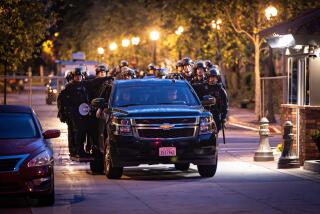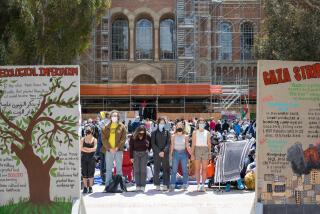A TIME FOR WAR: The United States and Vietnam, 1941-1975.<i> By Robert D. Schulzinger</i> . <i> Oxford University Press: 398 pp., $35</i>
More than 20 years after the fall of Saigon, Vietnam continues to haunt Americans. It is the war that never seems to go away, yet we still understand it poorly, if at all. Our memory is, at best, fuzzy; at worst, distorted. Many have embraced the myths that the defeat was self-inflicted; that the civilians would not let the military win; that we could have won if we had just fought differently; and that the national will was subverted by a hostile media and the antiwar movement.
Robert Schulzinger’s admirable synthesis, “A Time for War,” persuasively challenges these and other myths. A professor of history at the University of Colorado, Schulzinger surveys American involvement in Vietnam from the beginning of World War II to the collapse of South Vietnam. He has mastered the vast literature on the war. He makes excellent use of newly declassified documents from U.S., British and Canadian archives and of the private papers of government officials, congressional members and peace activists. The range of sources from the American side, at least, ensures an impressive richness of detail.
Much of what is covered here will be familiar to students of the Vietnam War, and the book does not break ground interpretively. But this up-to-date survey does provide balanced and convincing answers to what, for Americans, remain the most urgent questions. Why did the United States make such a huge and eventually disastrous commitment in an area seemingly so insignificant? And why, despite the size of the commitment, was the world’s greatest power unable to impose its will on what President Johnson once dismissed as that “raggedy-ass little fourth-rate country”?
Americans are notoriously ahistoric. If asked, most would probably date their involvement in Vietnam from 1965 or, perhaps, 1961. Schulzinger properly devotes about one-third of the book to the period before 1963. He wisely reminds us how far back we must go to comprehend the origins and outcome of a war that for the Vietnamese lasted more than three decades. He skillfully traces the origins of Vietnamese nationalism to their 1,000-year struggle against Chinese rule and the roots of the more recent conflict to the communist-led Vietminh Revolution against France at the end of World War II. He follows the fateful course of American policy, from the grudging and ultimately massive and futile support for France’s war against the Vietminh, to the assumption of responsibility for an independent, non-Communist South Vietnam after the inconclusive Geneva Conference of 1954, to the Americanization of the Second Indochina War under presidents Kennedy and Johnson.
Taking the war back to its roots is crucial to understanding its dynamics and outcome. Placing it in the context of Vietnam’s unrelenting struggle against outsiders--the Chinese, the French and, finally, the Americans--helps explain the otherwise inexplicable tenacity and ferocity of Vietnamese resistance. Considering American intervention against the backdrop of the nationalist revolution against French colonialism--something rarely done at the time--makes it impossible to see the war, as it was popularly viewed then, as part of the Cold War struggle between communism and the “free world.”
“A Time for War” also explains how the United States was drawn into a full-scale conflict through the process of incremental escalation. Schulzinger reminds us that for Americans, the war was never really about Vietnam itself. From Harry Truman to Richard Nixon, policymakers viewed it in terms of the Cold War.
In the early days of the Vietnam War, Americans felt compelled to support the French lest a neutral stance weaken their solidarity with European allies against the Soviet Union. Throughout the process of escalation, they saw the Cold War as a global conflict, all parts of which were interconnected. Weakness in one area might tempt Communist “aggression” in another. Hence, a persistent concern about its credibility drove the United States toward greater commitment in Vietnam.
Schulzinger also documents a widening gap among policymakers between private pessimism and public optimism. To maintain public support for an increasingly costly commitment, United States officials had to put on a happy face. In truth, they were plagued by doubts. Yet at every step, they plunged ahead because the consequences of inaction always seemed more dangerous.
Of course, no one could foresee the grim outcome. Success and prosperity since World War II had given Americans a “sense of near invincibility,” Schulzinger observes. Nothing as “catastrophic as the Vietnam experience had happened before in U.S. foreign policy, so why should the doomsayers be right now?”
Schulzinger properly dismisses filmmaker Oliver Stone’s “grotesquely fictionalized” efforts to set President Kennedy apart in the movie “JKF.” There is not one shred of evidence that JFK planned to extricate the United States from what he had come to see as a quagmire. His oft-cited comments about getting out represented “more the musings born of frustration with [South Vietnamese dictator Ngo Dinh] Diem than an acceptance of a Communist triumph.” Whatever Kennedy’s intentions, he bequeathed to his successor a “terrible legacy.”
Almost half the book is devoted to what the Vietnamese call the “American War” (1965 to 1975). Here again, Schulzinger skillfully summarizes the major events. He sharply analyzes the competing strategies and provides insights into the experiences of ordinary Americans and Vietnamese. He includes an excellent chapter on the home front and details the pervasive effects of the war in the United States and the rise of a fragmented, but increasingly influential, antiwar movement. Interestingly he, unlike most writers, finds positive results from the war. Americans now demand greater responsiveness and accountability from their government. The United States is a louder, more diverse and more democratic country because it went through the “agonizing experience of Vietnam.”
Although many Americans cling to the notion that the war could have been won, the author firmly endorses a growing consensus among historians: The war was not winnable at a cost Americans were willing to pay. This harsh reality, he reminds us, had more to do with the internal dynamics of the conflict than it did with what America did or did not do. The North Vietnamese regime and its allies in the south gained legitimacy from its revolution against France. And the South Vietnamese regime, whose roots went back to the French puppet governments of the 1950s, lacked legitimacy and the ability to function on its own. The more it looked to the United States for help, the more dependent it became. Its rapid collapse after America’s military withdrawal was all but preordained.
Sharply divergent concepts of history provide a key to understanding the outcome. Throughout much of their long history, the Vietnamese had fought outside invaders and, thus, they thought in terms of years, not days, of centuries not decades. Lacking this long historical view and spoiled by success, the Americans, by contrast, were impatient. Because Vietnam was never considered strategically important, there were sharp limits to the price they would pay. The North Vietnamese perceived this and exploited it.
Historian Robert McMahon has observed that the writing on the Vietnam War is “overwhelmingly produced by Americans, asking American-oriented questions and seeking answers in documents produced by Americans.” As do most other American authors, Schulzinger attributes American intervention and failure to cultural arrogance and abysmal ignorance of Vietnam and the Vietnamese. Yet his book, along with other comparable surveys, does not entirely succeed in dispelling that ignorance.
The growth of Vietnamese nationalism is well-handled in these pages, but the more deeply America becomes involved, the more the Vietnamese recede into the background, becoming shadowy figures whose actions remain obscure.
Little is said about North Vietnam’s decisions to support the National Liberation Front insurgency in the South in the late 1950s or to escalate the war in the 1960s. No explanation is given for the NLF’s control of the southern countryside, and the author often refers to the insurgents as the “Viet Cong,” a pejorative term that the Americans and the South Vietnamese used to defame all insurgents. Nothing is said of the tensions and differences between the NLF and Hanoi, and Schulzinger overlooks mounting evidence that the seemingly endless struggle weighed as heavily on enemy soldiers as it did on Americans, with widespread disillusionment setting in long before the war ended. Like most American writing on Vietnam, “A Time for War” does not fully bridge the chasm of ignorance that separated us from our Vietnamese allies and enemies at the time.
Our inability as a nation to make this cultural leap is of more than academic importance. There is little indication in recent political debates on possible American intervention elsewhere in the world that we have learned an essential lesson of Vietnam: the need to understand and respect the history, culture and local dynamics of places where we contemplate involvement.
Nevertheless, “A Time for War” is a valuable survey of the defining event in recent American history. Thoroughly researched, well written and persuasive in its conclusions, it deserves a wide readership.
More to Read
Sign up for our Book Club newsletter
Get the latest news, events and more from the Los Angeles Times Book Club, and help us get L.A. reading and talking.
You may occasionally receive promotional content from the Los Angeles Times.







